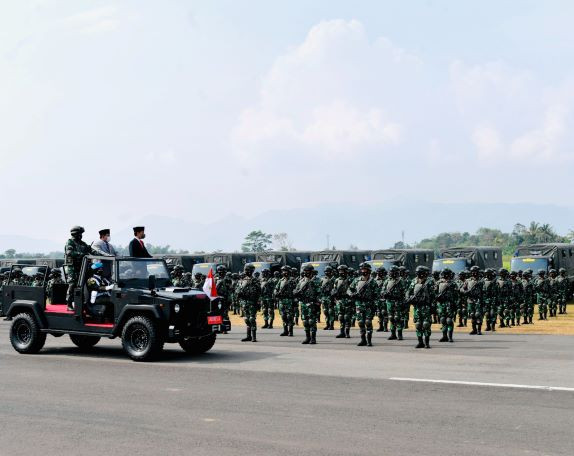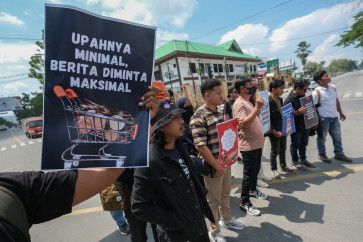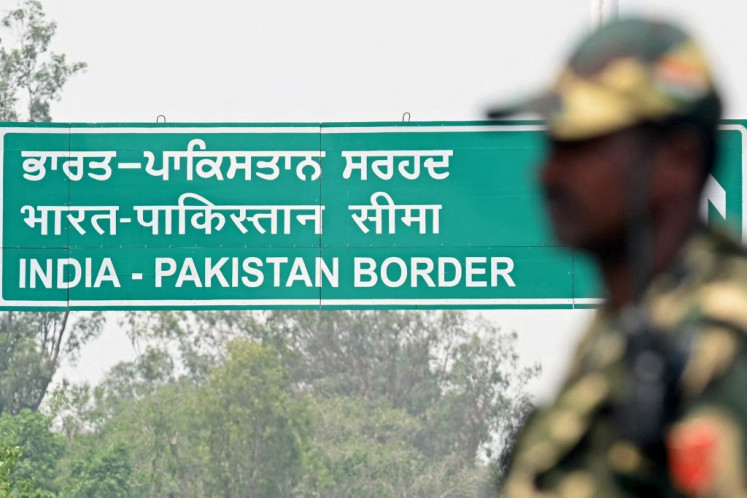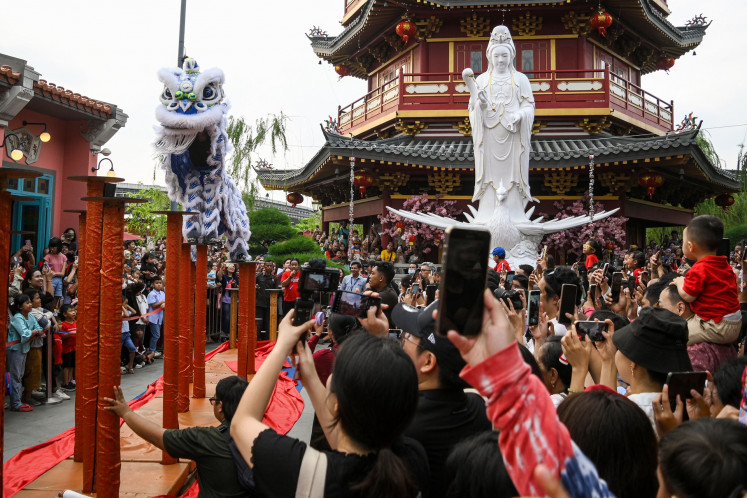Testing the legitimacy of reserve component
Understanding hybrid threats as an entry point for hybrid warfare is a strategic precaution.
Change text size
Gift Premium Articles
to Anyone

T
he constitutionality test of the provisions on the Supporting Component (Komduk), Reserve Component (Komcad) and non-human aspects in Law No. 23/2019 on national resource management for state defense (PSDN Law) is a fascinating legal phenomenon to be observed through a judicialization of politics analysis.
When analyzed using Ran Hirschl’s theory (2008), the constitutionality review filed with the Constitutional Court is a form of public support for judicial power in examining mega-political issues, especially regarding civil and military relations, and this also presents an opportunity of defense policy reformulation through the judiciary body.
The narrative then poses two reflective questions. First, what are the key messages from the judicial review of the PSDN Law? Second, what is the preference of the court justices on the petition for judicial review of the law?
The first key message concerns the total defense discourse in relation to the PSDN Law. Fundamentally, it has reopened other possible interpretations on the debate about the national defense system, namely, people’s defense and total defense.
The 1945 Constitution’s second amendment has normatively laid out the elements about the concept of people's defense and yet, it has not fully explained the normative elements and demands of total defense. This leaves much room for interpretation, which will encourage the formation of open legal policies, as seen in the PSDN Law, the Defense Law and the Defense Industry Law.
On the other hand, the provisions of Komduk and Komcad in the PSDN Law are derivatives of the total defense concept with duality characteristics; constitutional mandate and defense doctrine.
The second key message concerns the management of national resources to support national defense. What fundamentally has been missing in the public discourse is that the regulation of national resources aims to strengthen the main component and the main strength according to the Constitution, namely the Indonesian Military (TNI) as a defense tool. While philosophically, the national resource management exists as part of the gotong royong (mutual assistance) principle that reflects Pancasila.
The third key message is that the existence of Komduk, Komcad and non-human elements—natural and artificial resources, as well as national facilities and infrastructure—primarily aims to sustain the total defense system. Thus, legally we have the instruments to mobilize existing resources in times of emergency.
The fourth key message is on the operationalization of Komduk and Komcad to deal with military and hybrid threats. It sets a basis for both Komduk and Komcad to remain under democratic control, as it is a cardinal principle in civil and military relations.
By law, the two civilian authorities fully responsible for the administration of Komduk and Komcad, are the Defense Ministry and the President. On the other hand, during Komcad mobilization, the Constitution requires the President to declare a state of emergency beforehand and be approved by the House of Representatives, and similarly the same mechanism is required when the President mobilizes the TNI.
The last key message is that the existence of a threat classification regulated in the PSDN Law is concretely an evolution of thinking toward the ever-growing spectrum of threats.
When using the opinion of the Constitutional Court in its Decision No.7/PUU-X/2012, the court provides instructions that to define threats, it is necessary to look at a wider spectrum and not be structured rigidly, considering the increasingly multidimensional characteristics of threats. In another sense, threats can take the form of hybrid threats.
Thus, the classification of threats regulated in the PSDN Law has basically taken into account the development of evolving threat characteristics. This was interestingly illustrated when policymakers needed to consider the Ukraine crisis in 2014-2015, where hybrid threats that targeted the enemy's self-vulnerabilities resulted in hybrid warfare.
Understanding hybrid threats as an entry point for hybrid warfare is a strategic precaution. This is because hybrid warfare has an impact on the enemy's strategic and doctrinal weaknesses, while still maintaining strategic denial and surprise (Brin Najzer, 2020).
Finally, the persona approach and behavior of the Constitutional Court justices can be used to answer about their preference in viewing the discourse, as mentioned in the CSIS Commentary "Contextual Analysis of Two Constitutional Court Decisions" (2022). With this approach, contextually, Komduk and Komcad are rational choices for a cluster of justices with strategic-soldier character to defend the provisions as instruments that aim to ensure the sustainability of the state's existence and that are beneficial in times of military emergency or war.
On the other hand, the cluster of justices who use a positivist-legalistic and legalistic-textualist approach emphasizes that non-human elements, including natural resources and artificial resources, must be mentioned first in the Constitution. It thus can be said that the provisions in the PSDN Law can potentially contradict Article 30 of the 1945 Constitution.
However, this cluster of justices tends to maintain the operationalization of Komduk and Komcad to face military and hybrid threats. This is because the existing democratic control principles are implemented properly, as to not violate the rule of law principles in a democratic state.
In short, the strategic-soldier judges cluster needs to use more efforts to convince about the urgency of the PSDN Law, especially the instruments used to face situations of danger or evolving threats. The rational choice approach, practical assessment and the cluster of “game changer” judges have become crucial, as they are more inclined to answer fundamental problems and avoid constitutional drama, rather than to answer the constitutional questions they face. Moreover, they will be the ones who decide whether the PSDN Law is aligned with the 1945 Constitution or not.
In closing, an analogy to describe the concepts in the PSDN Law can be illustrated using a total football scheme in which a football game is imagined as an architecture and an organic, collaborative art form. In other words, each element takes on a role and knows the tempo setting of defensive or attacking positions, utilizes existing space and resources, and finally requires a conductor to regulate the orchestration of the game (David Winner, 2000).
***
The writer is a researcher at the Department of Politics and Social Change, Centre for Strategic and International Studies (CSIS), Jakarta.









